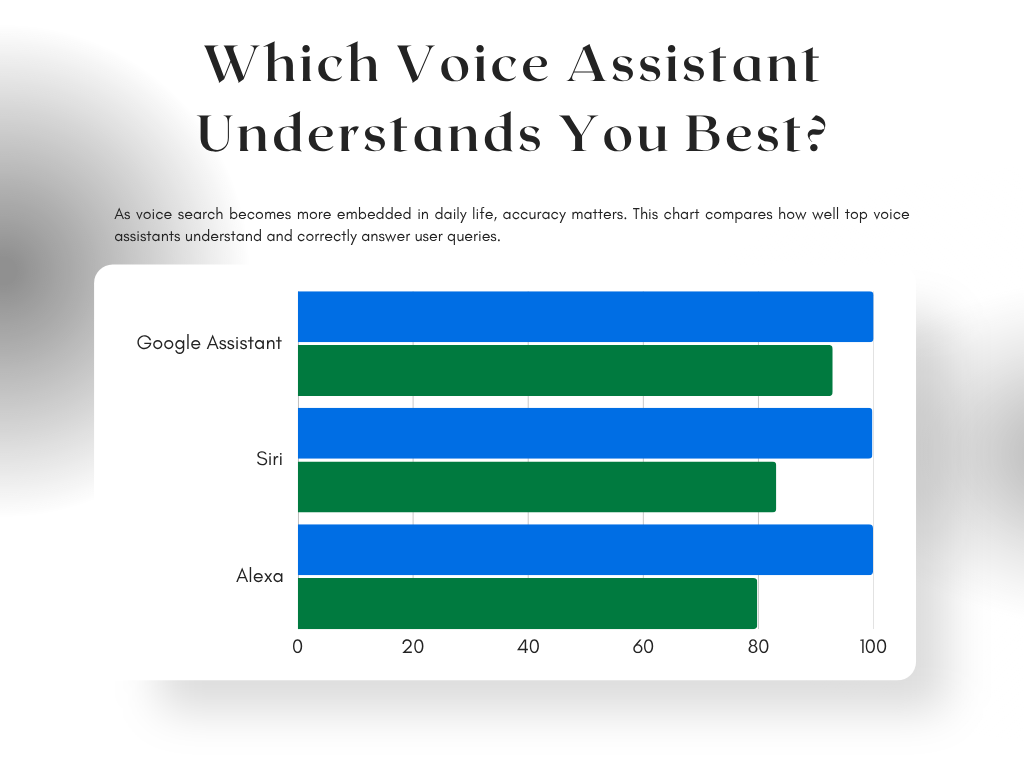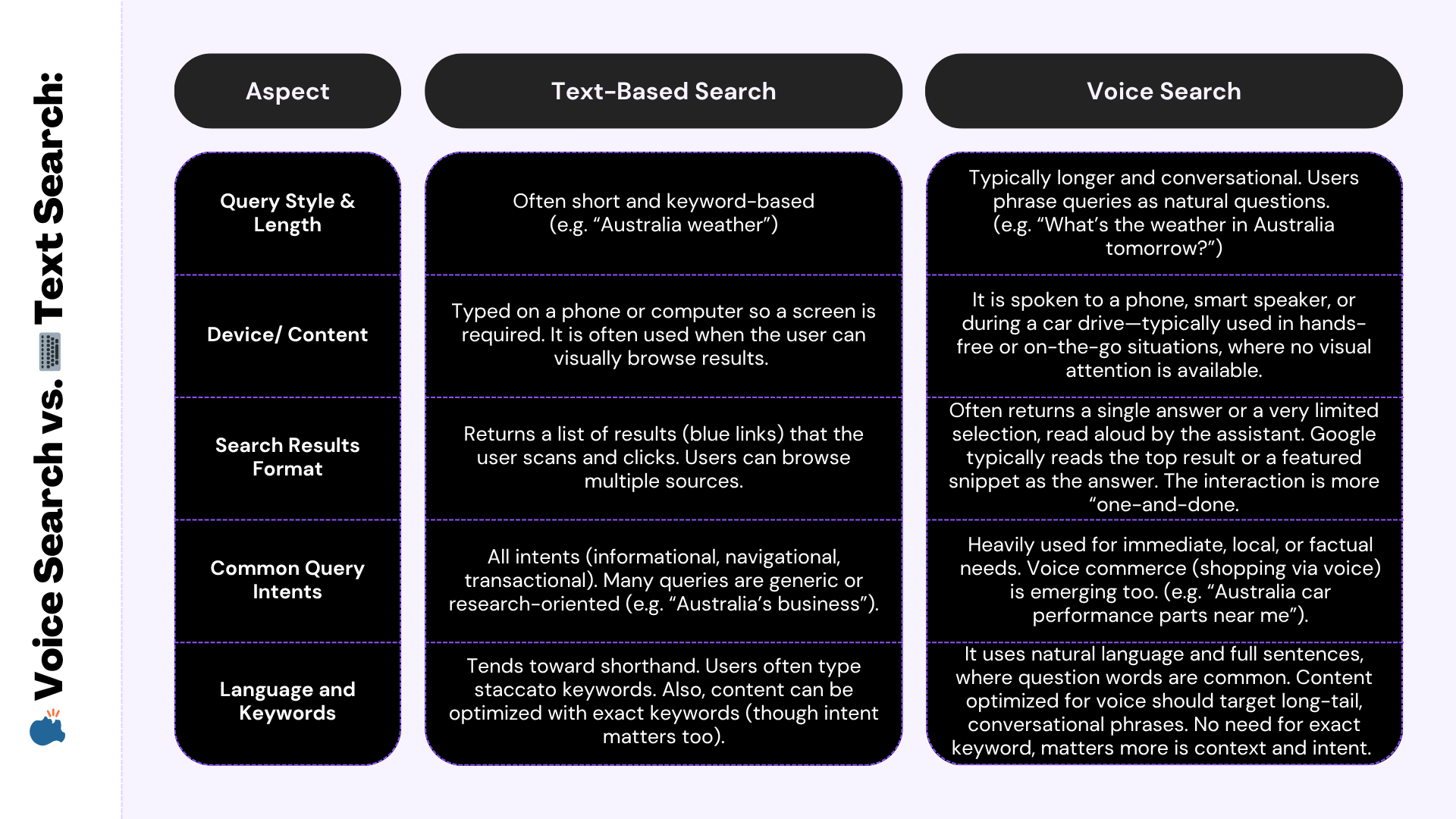Voice Search SEO: How to Get Your Brand Heard on Google (with Expert Insights from LTBS)

Adam Baoudunnov

“Hey Siri, what’s the best modern furniture in Australia?”
“Hey Bixby, can you help me find the best automotive accessory?”
“Alexa, find me the best shower gel around near me.”
You’ve probably done this yourself or heard someone do it through their phone—and that means you’re already experiencing voice search engine optimization (SEO). For sure, once in a while, you do it whenever you feel like being a bludger.
Voice search isn’t just a futuristic novelty anymore. It’s already here, and it’s changing how people find information online. From asking the new assistant Gemini through your phone to find the best food around you to getting help from Google Assistant to locate the nearest coffee shop, to querying Alexa or Bixby about today’s news; more consumers now speak their queries instead of typing them.
This shift toward voice search is reshaping SEO strategies and content marketing in real time. But what exactly is voice search, and why should your business care?
In this post, we’ll explore what voice search is, how it’s evolving on Google, its impact on SEO and user behavior, and what experts (including our team at Local Threads Brand Solutions) suggest for optimizing content in a voice-first world.
We’ll also look ahead at trends and predictions for the next few years, backed by stats and insights from industry leaders.
What Is Voice Search (and How Is It Evolving)?
Simply put, voice search allows users to speak their queries aloud to get answers, rather than typing into a search bar. On Google, voice search is often facilitated by voice assistants like Google Assistant, whether on smartphones via the Google app or Android voice input, smart speakers like Google Home or Nest devices, or even desktops via Chrome’s voice search.
Users might ask conversational questions like, “Hey Google, what’s the best Australian restaurant near me?” and receive a spoken answer or search results read aloud.
Voice search technology has come a long way in a short time. Early voice recognition systems decades ago could only understand a handful of words, unlike today. Today’s voice assistants use advanced natural language processing (NLP) and AI to understand nearly any request.
Google’s 2019 introduction of the BERT algorithm, and more recently MUM has significantly improved the search engine’s ability to interpret natural, conversational queries. This means Google can better grasp the intent behind long, spoken questions and provide more accurate results.
Voice queries often include question words and more context (e.g. “Where can I find a late-night pharmacy downtown?”) – and modern search algorithms are increasingly equipped to handle these nuances.
Notably, voice search is no longer confined to phones or smart speakers. It’s everywhere and people use voice assistants on smartphones, in cars, on smart TVs, and even appliances because of its convenience.
In fact, recent studies suggest that over 40% of Australians use voice search regularly, driven by the widespread adoption of smart devices. Smart TVs, car infotainment systems, and other IoT devices are also becoming voice-enabled.
The expansion of voice-capable devices means voice search is becoming a present of the digital ecosystem, seamlessly integrating into daily routines and means users can search by voice virtually anywhere and anytime.
As voice search usage grows, it’s also getting more accurate and user-friendly.

Moreover, as consumers continually use this, they might also use voice technology even more in the future, as the Australian speech recognition market is projected to grow at a CAGR of 14.25% to 2030, reaching AU$494.11 million by the end of the period, showcasing that it will continue to get better and more integrated into devices.
Voice Search vs. Text Search: How Do Queries Differ?
Voice queries differ from typed queries in a few key ways, and these differences have implications for SEO. Here’s a quick comparison:

In essence, people talk to search engines differently than they type. Voice searches are more conversational and often intent-specific. For every digital marketer and growth partners, this means our content strategy must adapt to capture those natural-language questions and provide on point helpful answers.
How Voice Search Impacts SEO, Content Strategy, and User Behavior and LTBS Expert
The rise of voice search is pushing SEO and content strategy in new directions. Below are some of the major impacts along with actionable strategies and expert tips from LTBS and other industry leaders on how to adapt effectively:
Conversational Keywords: Think Like Your Audience
Since users speak in full questions, successful content must incorporate the phrases people actually say. This is sometimes called Voice Search Optimization (VSEO) optimizing for the way questions are verbally asked in day-to-day life.
So, businesses should research common questions in their niche and weave those Q&A-style elements into their pages. After that, you have to think like your audience, knowing what tone and their questions that need to be answered.
At LTBS, we immerse ourselves in making our content natural and from the perspective of customers. We also keep it conversational, as many experts emphasize adopting the consumer’s natural language in order to bridge the gap between user and content, increasing the chance your page becomes the spoken answer.
Also, Neil Patel of Answer the Public highlights that we should optimize for how real people ask questions, not phrases that feel forced into a keyword tool. If your customer would say, 'What’s the best automotive accessory this 2025?', your content should literally have an answer to that question phrased in a similar way.
Featured Snippets and Quick Answers
In voice search, positioning yourself as #1 is more important than ever. Google Assistant often reads aloud the content of a featured snippet (the answer box on top of search results) or the top result.
If your content isn’t in that spot, it likely won’t be heard at all. This makes strategies for capturing featured snippets crucial using clear question-and-answer formats, schema markup, and providing concise definitions or steps.

SEO thought leaders often stress the importance of capturing featured snippets for voice. A modern SEO playbook suggests structuring content with direct answers at the top, lists or tables for steps, and using headings that reflect common questions.
Our team at LTBS does this and makes sure the content is speakable, since it’s an easy way for Google to include it in voice search. Moreover, starting your content with a paragraph with a question that a user might ask and immediately answering it, makes the Q&A style both user-friendly and voice-friendly.
Additionally, digital marketing forums and guides frequently mention that Frequently Asked Questions (FAQs) pages are a great way to achieve this too, as you list questions and answers that search engines can easily pull from.
Long-Form Content Still Matters
Many are missing the importance of long-form content and instead choose and rely on short form content. It may seem counterintuitive, but while answers need to be concise, the pages that provide them tend to be comprehensive.
A study found that the average word count of pages that rank for voice search is around 2,300 words and more. Google prefers authoritative pages to pull answers from. That means your content should thoroughly cover the topic and earn Google’s trust to use it as an answer.
But take note that it should also have a segment that summarizes the answer succinctly in order to satisfy the voice query immediately. A good tactic is to have an FAQ section or a brief answer at the top of a detailed article.

Additionally, SEO experts frequently recommend implementing structured data to boost voice search success. By adding FAQ schema or How-To schema, you increase the chances of getting rich results and being chosen for voice answers.
For instance, Google might read out an FAQ answer from your page if it matches a voice query. Also, Speakable schema is specifically meant for voice that signals which portions of your page are best suited to be read aloud.
Search Engine Land points out that speakable markup is an important tool for making content voice-ready, especially for news and informational articles. Early adopters of such schema could gain an edge in voice search visibility.
Another thing to consider is creating content specifically for voice platforms. While Google has scaled back third-party conversational actions to some degree, brands can still provide value via voice by integrating with platforms like adding your business to voice commerce directories, or providing feed data for voice apps.
At minimum, monitor how your content is performing in voice. Use tools and services that let you see if your site is being used as a voice answer. This feedback can guide your strategy like if certain questions are driving voice traffic and through that you can create more content around those topics.
Natural Tone and Readability
If you’re making content it should have the tone for a voice where it needs to be conversational. If the assistant is going to read your text aloud, it should sound natural and easy to understand.
If it has complex, jargon-laden sentences might not play well in audio. In practice, LTBS advises writing in a clear, human-friendly style that asks real questions. Adopting that mindset in content creation can improve both voice and text SEO performance.
Local SEO and “Near Me” Queries
One of the most important to highlight in local seo is how huge impact voice search has. Many of the queries people voice are location-based “Where’s a good pizza place near me?”, “Find a modern furniture store open now”.
According to recent statistics, an estimated 72% of people who own voice-enabled devices use them to search for local business information regularly. Google has observed the surge in “near me” queries as well as local intent.
Experts in local digital marketing, including our team at LTBS, note that voice search and local search go hand-in-hand. LTBS advises businesses to optimize product listings and content for voice search to ensure maximum visibility and discoverability in voice-driven shopping and local queries. This means not only having great on-site content, but also ensuring your business information is voice-ready

This is why you need to update or optimize your local presence. Voice assistants pull data from Google’s index, Google Maps, Yelp, and other sources to answer local questions. So, maintaining consistent NAP (Name, Address, Phone), ensuring your Google Business Profile is up to date across directories, gathering positive reviews, and using natural language in descriptions can all help
If someone asks, “Which automotive brand is open on Sunday near me?” or “Do I need an appointment at LTBS?”, having answers to these questions and information readily available on your site or Google listing can make the difference in being the voice result.
User Behavior and Content Consumption
This is also becoming crucial as humans continue to multitask every task. Not everyone who uses voice search is blanger, it can also mean they are multitasking work, and this is changing how users behave.
People using voice want immediate, audible answers while not even looking at a screen. This means if your site is the one being read aloud, you’ve delivered the info without a click. On one hand, this could mean fewer traditional website visits, the so-called zero-click search trend, since the assistant might satisfy the query in voice.
On the other hand, being the trusted answer can boost your brand authority and lead to follow-up actions like navigation requests to your store, or the user asking for your phone number next.
Marketers should monitor not just web traffic, but other engagement signals (calls, directions, voice-driven actions) as indicators of success in the voice era.
Changes in Search Habits
As noted earlier, voice search tends to be used in contexts where typing isn’t convenient. The common use cases include texting or calling via voice, getting directions, playing music, checking the weather, and other hands-free tasks.
For content strategists, it’s important to consider when and why your audience might use voice. Ensuring your content is structured in a way that voice assistants can easily pull step-by-step answers like using How-To schema or FAQ schema could make your website the go-to answer in those scenarios.
Technical SEO Factors
Some technical aspects of SEO take on even greater importance for voice. Another thing to consider is the site speed which is critical since voice users expect an instant answer.
Pages rank well for voice search if they load much faster and have a mobile-optimized version. Voice results load about 52% faster than average, and implementing structured data can be a game-changer.
If your page is slow or not mobile-friendly, Google is unlikely to feature it as a voice answer because the user experience would suffer. Make sure your site passes Core Web Vitals, use a CDN, compress images, and so on.
To sum it all up, the rise of voice search is reshaping how businesses approach SEO and content strategy. The world of voice search has come a long way and holds great potential as it continues to evolve.
Every business should expect to see more integrated devices, more voice-searched content and products, and a sharper focus on privacy and accuracy.
Most importantly, creating clear, concise, and contextually relevant content is essential, as voice search rewards those who anticipate user questions and answer them effectively. The core principle is focusing on user intent and convenience.
If your content genuinely answers what a user is asking in a way they’d ask it out loud, then your site is technically prepared, and you’re on the right track.
Preparing Your SEO Strategy for the Voice-First Era
Voice search on Google and other platforms is no longer a moonshot idea, it’s a present reality that’s influencing how customers discover information and make decisions. As we’ve seen, it demands a shift in approach: content needs to answer questions directly and conversationally, SEO tactics must account for natural language and featured snippets, and local optimization is more important than ever.
The current state of voice search is one of growing usage and improving technology, but also tempered expectations. It’s not replacing traditional search so much as augmenting it. Users love the convenience of asking a quick question out loud and often that’s when they’re looking for something immediate or local.
Google is continually refining its voice search capabilities, from better understanding via BERT to new schemas like Speakable for publishers. Marketers should keep pace with these changes, ensuring their content and websites align with Google’s voice-friendly features.
At LTBS, this is what we always do with our content, optimise it based on how people naturally talk. We made sure to use those insights about your customers: what are their pain points? How would they voice a question about your product?
Through that, we build content, while also minding the technical side. Your page should be a fast, structured, mobile-optimized site since these are what stakes for winning in voice search. If your site loads slowly or can’t be crawled effectively, it likely won’t become the spoken answer to anyone’s question.
To sum up, here are a few key takeaways and action items as you craft a voice search-conscious strategy to your contents:
- Incorporate Conversational Phrases: Expand your keyword research to include full questions and natural phrases. Consider creating an FAQ section or Q&A content that directly uses those questions as headings, followed by clear answers.
- Optimize for Featured Snippets: Use brief answer paragraphs around 30-40 words to common questions, bulleted or numbered lists for “how-to” steps, and tables for data when appropriate.
- Enhance Local SEO: If you have a local presence, make sure your Google Business Profile is complete and updated. Also, include local keywords in your content naturally. Remember, a large chunk of voice searches are people seeking local info, so make sure to be the business that gets recommended.
- Implement Structured Data: Add FAQ Page schema, How-To schema, Product schema, etc., where relevant to help search engines understand and feature your content.
- Prioritize Speed and Mobile Experience: Ensure your website is technically sound, fast loading, mobile-responsive, and secure (HTTPS). Google tends to pull voice answers from pages that deliver quickly and safely. Make sure to use tools like Google PageSpeed Insights to find and fix any speed issues.
- Monitor and Adapt: Keep an eye on how the voice search trend evolves in your analytics and industry. You might not yet see a “voice” line item in Google Analytics, but watch for increased incidence of question-style queries leading to your site.What works today may need tweaking next year as Google’s algorithms and features always change.
By taking these steps, you’ll position your brand to thrive in an era when speaking to our devices becomes as commonplace as typing. As voice search continues to mature, those brands that deliver helpful, voice-optimized content will strengthen their connection with audiences.
After all, being the trusted answer to a user’s spoken question is a powerful place to be, it’s a sign of authority and trust because voice search isn’t magic; it’s just another way people seek information.
Brands that can effectively join that conversation, providing value in a friendly, accessible tone, will not only improve their SEO but also build loyalty in the process. So, in this voice-first world, ask yourself: What are my customers asking? Then after that make sure you’re also the one answering when they ask.
And if you think your content is ready to be the next spoken answer on Google? Let LTBS help you fine-tune your SEO strategy for voice search success. We’re here to make your brand heard, clearly and naturally. Let’s talk.
At LTBS, we don’t just optimize content, we align it with your growth goals. Consult us today and let’s grow your brand together.
